The Amazing Spider-Man #299: “Survival of the Hittest”
Spider-Man travels out to the wilds of Northern New Jersey to fight a crazy billionaire building a domed city for survivalists in secret, policed by his own private army, which is armed with stolen military weapons.
Meanwhile, Peter Parker continues to feel lost in his supermodel wife’s world.
And there’s a guy with a black costume lurking in the shadows…
Chance the Suburbs Credits
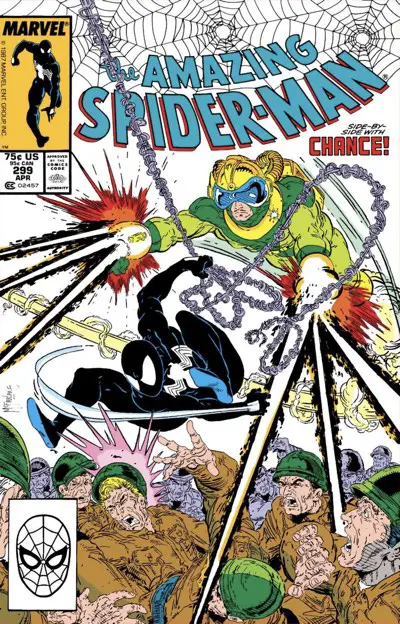
Pencils: Todd McFarlane
Inks: Bob McLeod
Colors: Bob Sharen
Letterer: Rick Parker
Publication Date: December 8, 1987
A Most Apolitical Political Story
The story is typical of the time in that it glosses over all the relevant questions and higher moral and political issues to deal with just the part of the story that is most likely to involve superhero hijinks.
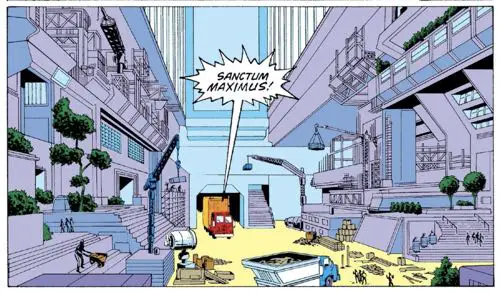
The rich guy wants to hide out in a dome and get his rich friends to pay him an enormous amount to buy a place there. To protect these world-weary survivalist one-percenters, he’s building an army to protect the facility and to keep the rabble out.
Side note: This is very different from current billionaire Marc Lore’s plan to build a city of the future named Telosa. (Because how else do you follow up Diapers.com and Jet.com?) That’s meant to be more of a utopia and less of a survivalist bunker.

The twist here is that the fictional rich guy, Carlton Drake, has chosen Chance for his weaponry and has kidnapped him to get it. Drake wants to learn the secret of how Chance can control the technology he uses to fly with those rocket boots and backpack.
But — here’s the twist! — he doesn’t want that to help his secret army. No, he wants to use that to raise a second army to keep a close eye on the first one to make sure it doesn’t get out of hand. Who watches the watchers, right? (The question of who watches the people who are watching the watchers never comes up.)
Also, picture that secondary army as a cadre of soldiers flying around on jet-powered boots just outside a domed city. Drake lives in a very weird sci-fi world all his own.
You can tell he’s the bad guy because just look at that Hilter ‘stache!
The story focuses on the struggle between Chance and his captors, and Spider-Man’s desire to remove the stolen military-grade weaponry from private hands.
There are far deeper issues than that, but “Amazing Spider-Man” is a superhero villain-of-the-month type book. It wasn’t going to stop for six issues to introduce us to some Survivalists, one of who likely wants to escape and is secretly aiding Spider-Man with information before losing her life trying to help him. Or, er, something.
You could see the modern spin on this clearly: The class divide issues, the high-tech angle of building a survivalist city, the military might, and how much responsibility comes with that much power.
Nah, this is about Spider-Man breaking Chance out and blowing the place up. In that way, it works. You get the gunfire, the acrobatics, and the explosion. Yee-ha!
If you want to consider the bigger issues, you’re more than welcome to do so after you put the comic down.
Maybe this is what people are talking about when they say they don’t want politics in their comics? It’s there. You can read into it. But the issue isn’t about who to levy additional taxes on, who’s more privileged than who, or the military-industrial complex. It’s not a series of characters acting as mouthpieces for the author to put a political point of view across.
It’s just a fun comic that leaves it as an exercise for the reader to read into it as far as that reader wants.
Just pondering…
A Single Issue Classic Spider-Man Story
By today’s standards, the story might be hokey. It is also, however, done inside this single issue. It’s a tight story, without a wasted page. There’s something new happening on every page, and nobody ever stands around to have a clever conversation.
Everything leads towards something plot-specific. David Michelinie is consistently moving his chess pieces across the board, particularly with the subplots.
The issue has a nice mix of classic Peter Parker action, with scenes at The Daily Bugle and Empire State University, to boot. Defining Spider-Man to be the put-upon hero, Michelinie’s script has him winning the day and preventing weapons from getting into a private militia’s hands, but Spider-Man still has to hitch a ride to get there and then ride Chance’s back to New York to get home.
The poor guy can’t catch a break.
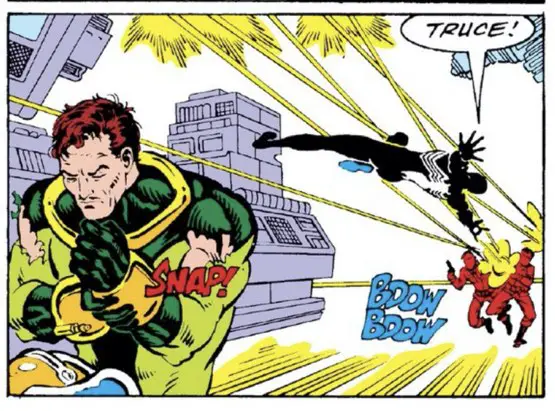
It’s another one of those repeated themes we’ll see in the series: Spider-Man has a soft spot for the bad guy. Spider-Man doesn’t have much of a choice here but does help Chance get loose to help fight off the army trying to take them down.
Even after that initial adrenaline rush is over, Spider-Man accepts Chance’s offer of a ride home. Getting back to a worried Mary Jane is more important than taking the villain in who nearly killed a military man last month, I guess. Truces are funny things.
I love Chance in a similar way to how I love Black Fox. Chance isn’t quite that old, but he does reference classic Hollywood stars in his time in this series. You just know he would love nothing more than to go back in time and see the Rat Pack performing in Vegas between his sessions at the Craps table. He’s also a bit in over his head, sticking to his gambling ways instead of maximizing his profit potential.
Story-wise, though, the issue is best remembered for the last two pages, in which Mary Jane comes home to find Venom waiting for her in the shadows. Creepy.
Spider-Man On (a Made Up) Location
The story uses the old generic and vaguely hand-wavey “Northern New Jersey” location for its setting.
Marvel writers will name specific neighborhoods in New York City where the action happens, but once the action crosses the Hudson River, it’s a generic location where anything can happen.
In this case, it’s a heavily wooded section where a dome has been built without anyone noticing. One caption box describes it as being off of “State Road G2.”
I’ve never heard of such a road, and I’ve lived in Northern New Jersey all my life.
To be the hard-hitting journalist that I am, I took a look for it on Google Maps. The only street it could find close to that was “Rue G2” in The Ivory Coast in Africa. (“Rue”, by the way, is the French word for “street.” So this review is back on brand for me.)
Here you go:

Nope, that’s definitely nowhere near here.
They do, however, speak French there, so it’s worth a visit to check out the bookstores for some fine bandes dessinees.
Venom’s Second Third First Appearance
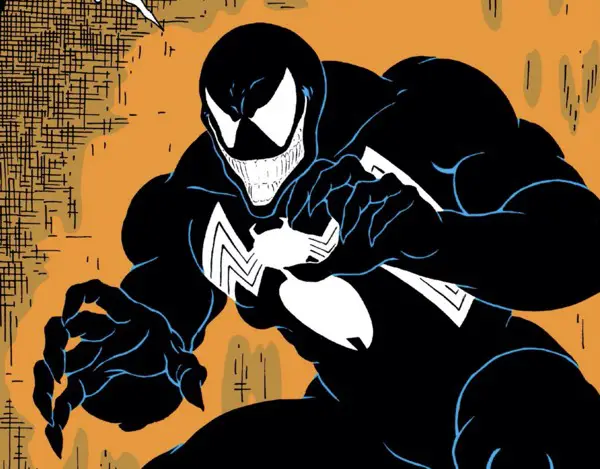
In issue #298, we saw Venom’s fist. Repeatedly.
Technically, that page would be the first appearance of Venom, right?
Many people don’t see it that way. They see issue #299 as Venom’s first appearance. You get a clear shot of the full character here, costume and all. You get his name. He actually does something.
Certainly, “The Amazing Spider-Man” #299 is, if not literally, then by general consensus and popular definitions, his first appearance. It’s only a page, but that’s more than enough for many other characters.
Right?
I mean, the book is fetching up to $900 in the collector’s market if you have a Mint/CGC 9.8 slabbed copy of it. That’s pretty convincing, isn’t it?
Hold that thought. We’ll get back to it with “The Amazing Spider-Man” #300.
Mary Jane: The Party Animal
I see this panel —
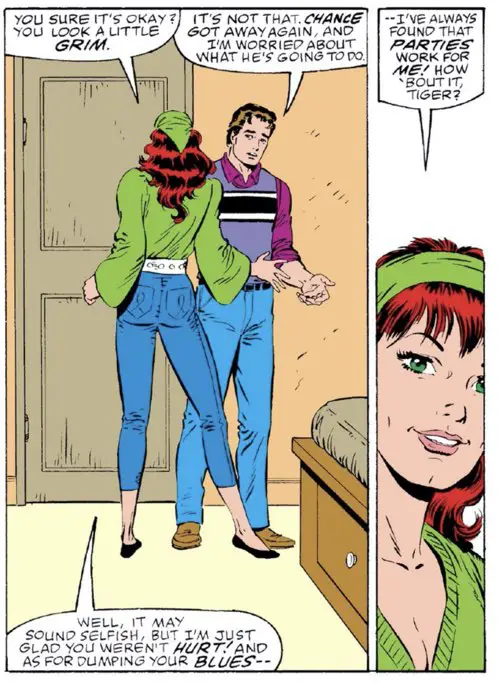
— and I can’t help but think of McFarlane’s adjectiveless “Spider-Man” #3:
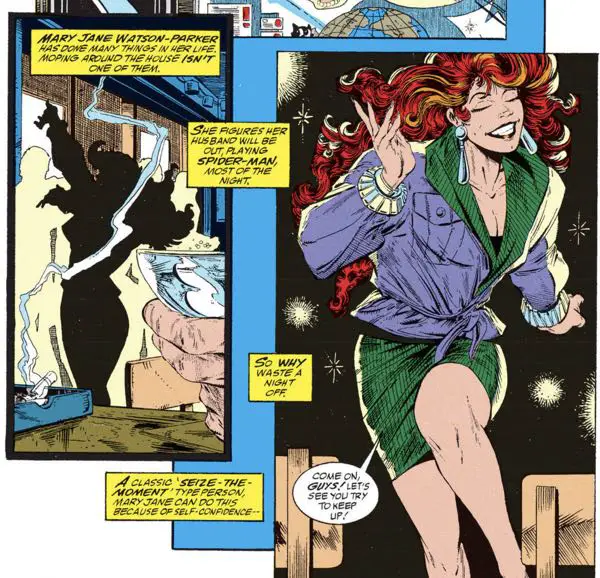
Do you think McFarlane thought of that line from David Michelinie when he wrote his own comic?
McFarlane on Inking
Bob McLeod inked McFarlane in this issue, so it looks a lot like the last issue did.
The difference in the finished look of the book is enormous once we get to issue #300, when McFarlane takes over inking duties.
It’s still clearly McFarlane’s pencils here, though. There’s no mistaking the exaggerated Spider-Man poses, the body language shown by both civilians and superpowered folks, and the general storytelling.
In “The Art of Todd McFarlane,” the artist talks of McLeod’s work on the book:
Not that he was a bad inker, but by this point in my career, I’d been inked by literally dozens of different inkers. Each one of them brought a different flavor to my pencil. I never felt that anyone was actually hitting it quite right in the way that I had it in my mind’s eye.
I’d just done some work on “The Incredible Hulk” where I did both pencils and inks, but Jim Salicrup was a little leery of letting me jump right into the fire of penciling and inking ‘The Amazing Spider-Man.’ He wanted to see if I could just get the storytelling and drama he needed out of my pencils first, before moving on to inking.”
It’s a common enough refrain from pencilers across the industry that they never find just the right inker or colorist for their style. When that happens, it’s magic, and the pair often are inseparable. (Think Scott Williams over Jim Lee or Mark Farmer over Alan Davis.)
McFarlane Trademark Designs
But not even a good inker could save McFarlane from the occasional incredibly wonky design choices in his work.
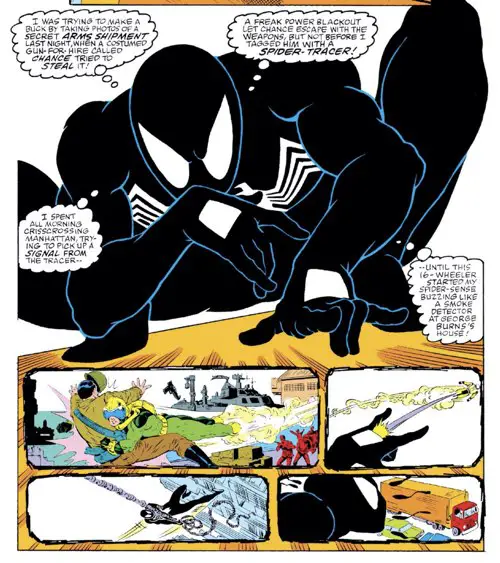
We can’t know what the original script said, but I don’t think this page layout serves the purpose too well.
Spider-Man recaps the last issue with four-word balloons, each of which could be easily linked to an image at the bottom of the page. It’s a bad layout choice. There’s no way those small panels packed that closely together in that position on the page could be used to accompany any amount of text.
McFarlane’s wonky page designs worked so much on “Infinity Inc.” because they stole the show but still worked with the story. Here, that tendency doesn’t serve the story at all. The reader is forced to wade through a wall of text, and then repeat the experience in pictures afterward.
As a design thing, I get what he went for there. The reality is that it didn’t work.
That’s So ‘80s!
Michelinie continues to explore Peter’s relationship with his new bride and her world in this issue, as she takes him to a party with an Eddie Murphy reference and a big-headed Paul Schaffer cameo. He looks more like Don Rosa crossed with Erik Larsen than Schaffer, though.
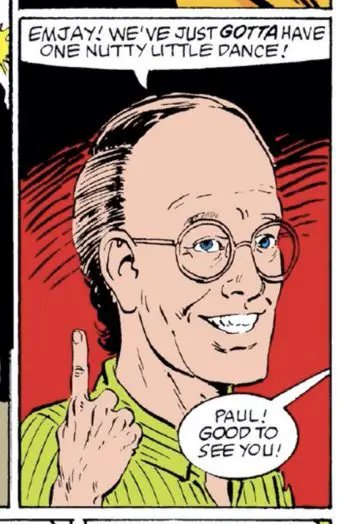
Also, his hand is way too small for that head.
In the “Art of Todd McFarlane” book, the original art to this page is shown. You can easily see where Schaffer’s head was pasted in on both panels he’s visible. Is that from McFarlane redrawing it so much he needed to paste in a new drawing? Or did someone else pencil the likeness for McFarlane to ink? Perhaps a Marvel Bullpen member?
That’s So Spawn!

My favorite part of the page, though, is the location of this party that Mary Jane has dragged Peter to. It’s “The Spawning Club.” Is that coincidence? Was McFarlane inserting a little in-joke?
He may not have done the final lettering — that’s Rick Parker — but maybe he sketched it in?
This isn’t the only Spawn link we’ll see in this series. Wait for issue #310, at the very least…
As with issue #298, McFarlane homaged his own cover for “Spawn” #299:
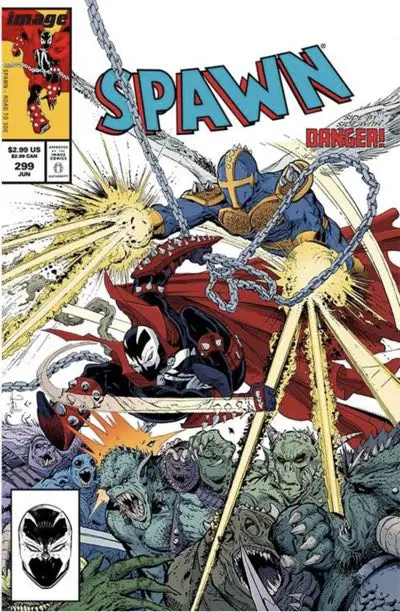
BD Recommendation
If you liked this issue, I have a recommendation for you from the world of les bandes dessinées, or Franco-Belgian comics.
Ah, yes, life in the suburbs is a crazy place for Spider-Man to try to swing. But imagine what would happen if he moved from the city out to an even more rural place?

Manu Larcenet and Jean-Yves Ferri’s “Back to Basics” series is loosely based on Larcenet’s real life experience of moving from Paris out to a more suburban/rural area. It’s very much a gag-a-page kind of comic strip in comic book format. It runs five hilarious volumes. A sixth was just published after a break of many years. Sadly, that new addition hasn’t been translated to English yet.
Check out my review of the first volume of “Back to Basics.”
Next Issue
Coming up in issue #300: Extra pages! McFarlane inks! The return of the red and blue! Oh, yeah, and that Venom dude who got so popular there for a time. Wonder whatever happened to him?
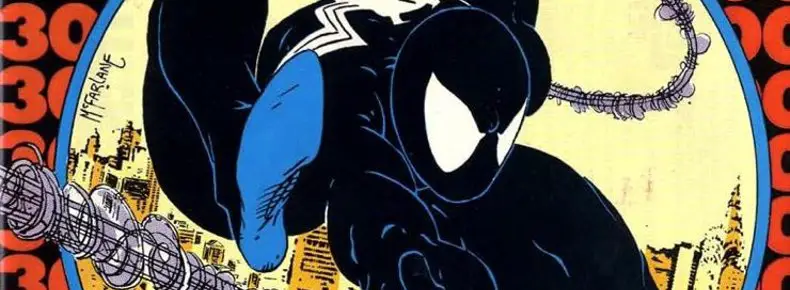
Bonus Panel
Presented without comment or context:
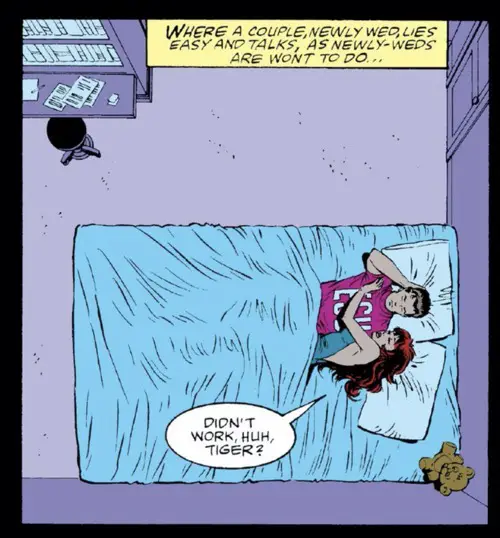

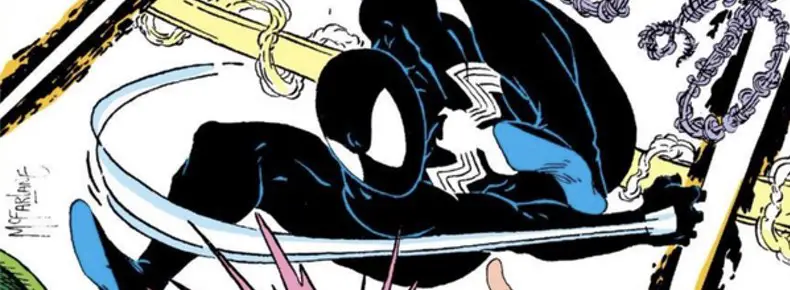
I do miss stand-alone single issues too.
This era marks to me the switch from writer-driven comics to artist-driven. Some see it as an improvement, I wouldn’t. I’m sad to say that Jack Kirby writing his own books, if it made them more cinematic and dynamic for sure, lacked the drive and the overall consistency of professional writing. Coming up with plot ideas and concepts, anyone can, but writing a tight story with a beginning, middle and end, dialogue that feels natural and flows, that requires skills. Uderzo certainly doesn’t have that, neither does McFarlane as you’ll see when you get there to the adjectiveless in the reviews. The image guys realized it when the hired seasoned pros like Alan Moore to give their books some much needed spine.
The art-driven era didn’t last long. Marvel and DC immediately changed their directions to favor the writers at the expense of the artists. Artists are now interchangeable cogs — the only ones who’s names they splash around are the ones who might sell alternate covers. Artists don’t last long on monthly titles. They’re swapped in and out seemingly at random. Whenever a new book is announced, it’s the writer’s book and the artist is named much later, like an after thought.
Also see last week’s announcements about Jodorowsky’s “The Incal” being adapted into a movie with no mention of Moebius’ name. When it comes to the big multimedia deals, the artist is chewed up, spit out, and never named.
It’s all rather shameful.
I haven’t committed to reviewing the adjectiveless “Spider-Man” issues yet, though there is a lot to talk about in there, too. Give me a couple of months and we’ll see how I feel about it. =)
You’re probably right about the writers backlash, except that with today’s editorial mandates of the big two, the writer him/herself is but a pawn on the board just as well. Unless you’re Grant Morrison in which case they let you run free, which is just as bad.
Artists are interchangeable today because they come from the same photo-tracing trend and comic art has become boringly stiff. At least one quality I would recognize to Todd and his Image colleagues, they were still producing dynamic pages. Not so much any more.
Yes I saw the Incal announcement, and that puzzles me that a book so entrenched in 1960-70 tropes and spawned so many offsprings can be adapted without plenty of eyerolls from younger generations (remember Valerian!).